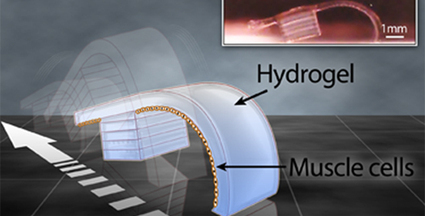| The Bio-Bot is 7 mm long and can move on its own |
The hydrogel part of the robot was made by a 3D printer. This makes the production of robots easier because more shapes can be made faster and easier. Because it is easy to print these plastics, several changes can be made fairly easily. The researchers can use trial and error as much as they need to improve the design of the bio-bot.
The bio-bot's unique structure allows it to manipulate into different shapes that would not be possible if it were made of metal and hard plastics. The soft plastic and cells allow the robot to be flexible, as well as function without the use of electricity. Rashid Bashir, one of the head engineers, stated “As engineers, we’ve always built things with hard materials, materials that are very predictable. Yet there are a lot of applications where nature solves a problem in such an elegant way. Can we replicate some of that if we can understand how to put things together with cells?” So far, they have been successful in creating functioning robots.
The researchers hope that these bio-biots could be used to detect chemicals in water, climb walls, or function as a sensor to react to certain elements in the water. If the bio-bots can be made using cells that respond to different stimuli, like chemical gradients, then they can definitely be used in drug screening and chemical analysis. The way the bot's motion changes would indicate the reaction of the cells to the environment and whether or not a similar reaction may occur in humans. It is the researchers' hope that if they can get the bot to move toward chemical gradients, they could design something that can look for a specific toxin and attempt to neutralize it.
 |
| A depiction of the movement of the robot |
http://news.discovery.com/tech/walking-bio-bot-made-with-cells-gels-121115.html
http://news.illinois.edu/news/12/1115bio-bots_RashidBashir.html
No comments:
Post a Comment